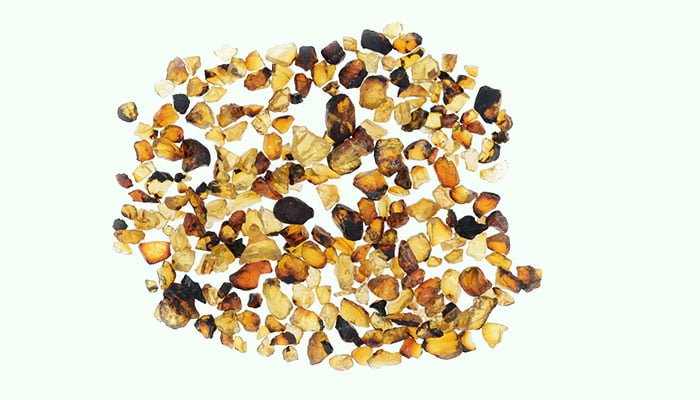What Is Hu Po
Hu Po commonly known as Succinum or Amber is the fossilized resin of pine trees, which is an evergreen tree belonging to the family Pinaceae. It is a precious mineral medicine, which first appeared in <Mingyi Bie Lu> around 420-589 AD.
There are about 118 species of Pinus, which are mainly distributed in the northern hemisphere. They are common trees for afforestation and greening. They are widely used in many fields such as construction, agriculture, chemical industry, medicine, and so on. Among them, the seeds of some pine trees are edible.
The formation of amber is a masterpiece of nature. The resin fell and was buried in the ground. After tens of thousands of years of high temperature and high pressure in the rock formations, they were petrified to form amber.
At present, the age of the oldest amber ore discovered in the world is around 99 million years old. They have a high collection value, ornamental value, and medicinal value. In prehistoric times, amber was used as currency for transactions. Now they are widely used in jewelry and accessories manufacturing. They symbolize noble, classical, and implicit beauty.
They are mainly distributed in glutenite or coal deposits in the Cretaceous and Tertiary. They can be found in countries such as Russia, Poland, France, the United Kingdom, Myanmar, Italy, Japan, India, the United States, Dominican Republic, China, and Mexico.
Amber is not extremely common. When workers find them in the stratum or coal seam, they dig them out, remove the sediment, and store them. Generally, bubbles and ancient insects, animal or plant debris are often seen inside amber.
Hu Po contains succinic acid, succinoabietic acid, succoxyabietic acid, succinoabietol, borneol, succinosilvic acid, succinin, succinoresinol, terpenes, semiterpenes, diterpenes, volatile oils and some trace elements.
Generally, the yellow-brown, blood-red, or dark-brown and fragile Hu Po with shiny cross-sections is preferred.
According to <Ben Cao Gang Mu Shi Yi>, the medicinal nature of Hu Po is relatively neutral, with a sweet taste. It has a certain therapeutic effect on the pathological changes of the heart, liver, and bladder meridians.
In traditional Chinese medicine, it is often used to relieve convulsion to tranquilize the mind, promote blood circulation to dissipate stasis, promote urination to relieve stranguria, and treat palpitations, restlessness, intractable insomnia, amnesia, epilepsy, convulsions, chest tightness, amenorrhea, dysmenorrhea, irregular menstruation, acute gynecological pain, postpartum urinary retention, endometriosis, abdominal mass, nebula, concussions, coronary heart disease, angina pectoris, acute urinary tract infections, chronic prostatitis, hemorrhoids, anal fissures, perianal eczema, chronic skin ulcers, scrofula, sleepwalking, arrhythmia, and burns.
There are about 50 kinds of Chinese medicine prescriptions containing it, such as Hu Po An Shen Wan, Hu Po bao Long Wan, and Mayinglong Musk Hemorrhoids Ointment.
Benefits
- Reducing the autonomous activities of mice, and cooperating with pentobarbital sodium to extend the sleep time of experimental mice.
- Raising the pain threshold and inhibiting the pain caused by the mouse hot plate experiment and the acetic acid experiment.
- Antagonizing rat auditory convulsions and mouse electroconvulsive convulsions, and prolonging the incubation period of mouse convulsions.
- Inhibiting gastric ulcer caused by pyloric ligation in rats.
- Relieving convulsion to tranquilize the mind, treating restlessness, restlessness, palpitations, insomnia, forgetfulness, pediatric convulsion, fetal convulsion, and fetal epilepsy.
- Promoting blood circulation, treating dysmenorrhea and amenorrhea caused by qi stagnation and blood stasis.
- Treating chest obstruction with pain caused by stagnation of the heart blood.
- Dispersing blood stasis, and treating accumulation of abdominal mass.
- Promoting urination, treating urolithiasis, heat stranguria, frequent urination, painful urination, and urinary retention.
- Healing sore and promoting tissue regeneration, treating chronic skin ulcers.
- Studies have found that intraperitoneal injection of succinic acid can lower the body temperature of normal mice.
Combinations
- It can be used in combination with Tian Zhu Huang (Bamboo Sugar), Fu Ling (Poria), Dan Nan Xing (Arisaema cum Bile), etc to treat infantile convulsion.
- It can be used in combination with Dang Gui (Radix Angelicae Sinensis), E Zhu (Rhizoma Curcumae), and Wu Yao (Radix Linderae), etc to treat dysmenorrhea and amenorrhea caused by qi stagnation and blood stasis.
- It can be used in combination with Shui Zhi (Leech), Rou Gui (Cinnamomi Cortex), Da Huang (Radix et Rhizoma Rhei), etc to treat amenorrhea caused by blood stasis.
- It can be used in combination with San Leng (Rhizoma Sparganii), Bie Jia (Carapax Trionycis), Da Huang (Radix et Rhizoma Rhei), etc to treat the accumulation of abdominal mass.
- It can be used in combination with Jin Qian Cao (Lysimachia), Hai Jin Sha (Spora Lygodii), Mu Tong (Caulis Akebiae), etc to treat urolithiasis and heat stranguria.
Side Effects
- At present, there is no data showing that serious adverse reactions will occur when taking Hu Po according to the regulations.
- Animal experiments have shown that excessive consumption of it can lead to reduced animal activity.
Precautions and Warnings
- The dosage of Hu Po should be controlled at 1.5-3g.
- It can be made into pills, powders or wines, or ground for external use.
- People who are allergic to amber should not take it.
- Patients with internal heat due to yin-deficiency should not take it.
- Patients without stagnation of qi and blood should not take it.
- Pregnant and breastfeeding women should not take it.
- Children, the elderly, and the infirm should not take it.
